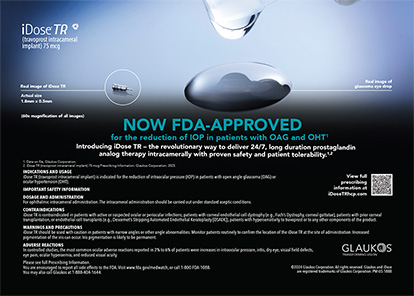In this month’s installment of “Residents and Fellows,” our colleagues from the Moran Eye Center at the University of Utah explain the importance of angle kappa and its implications in cataract and refractive surgery. For surgeons, understanding the intricacies of angle kappa can help you guide patients to the right IOL choice (or more importantly, keep you from using the wrong IOL). Dr. Moshirfar and Mr. McCaughey present this information in a manner that is very easy to understand and comprehensive. I hope you enjoy this installment and I extend an invitation to readers to submit topics for publication.
—Section Editor Sumit “Sam” Garg, MD
Angle kappa is defined as the angle between the visual axis and anatomic axis (ie, the pupillary axis) of the eye (Figure). A positive or negative angle kappa may result in a nasally or temporally displaced light reflex, respectively. Despite the fact that the vast majority of patients have a minimal degree of measured angular variation,1-3 it is important for the refractive surgeon to be cognizant of potential postoperative sequelae that may arise in patients who have comparatively high angle kappa values.
SURGICAL IMPLICATIONS
Hyperopic patients tend to possess larger angle kappa values,4 and they therefore represent the predominant patient population of interest concerning this topic. A large angle kappa value can contribute to inadvertent decentration of multifocal IOLs or regions of laser ablation, potentially resulting in substandard visual outcomes of lenticular or corneal refractive surgery and patients’ subsequent frustration.
Multifocal IOLs
The rising popularity and implementation of multifocal IOLs has resulted in an associated increased awareness of postoperative bases for patients’ dissatisfaction. Complications specific to multifocal IOL implantation include the development of postoperative glare and halo aberrations, which in certain circumstances may necessitate IOL exchange. Larger angle kappa values have been correlated with an increased proportion of subjective complaints related to postoperative glare and halo formation in patients who had previously undergone multifocal IOL implantation.6
Normal angle kappa values in an emmetropic population, as measured by scanning-slit topography, have been estimated at 5.55 ±0.13º and greater than 5.62 ±0.10º in right and left eyes, respectively.4 Although the precise degree to which a larger-than-normal angle kappa contributes to decentration is not agreed upon, it is nonetheless worthwhile to consider the relative propensity for pupillary and visual axis misalignment, particularly in hyperopic patients who request multifocal IOL implantation.
Laser Refractive Surgery
With regard to laser refractive surgical procedures, there are differing opinions about the optimal anatomic site for orientation of the ablation: centered on the pupillary center versus the corneal vertex. Pupil-centered ablations generally result in satisfactory outcomes for the vast majority of patients, due to the relatively low frequency of high angle kappa values within the general population. Implementing this strategy may prove to be problematic for patients with high angle kappa values. A pupil-centered ablation in a patient with a large angle kappa may result in a significant degree of dissociation between the ablated zone and the visual axis, potentially resulting in induction of astigmatic error and suboptimal refractive outcomes.
Several authors have documented the functionality of using the CSCLR,1,7 which is thought to best approximate the position of the visual axis,8 as an indicator for centration of ablation. Determination of the CSCLR may be performed preoperatively on the basis of topographic scanning, which can determine the degree of alignment disparity between the pupillary center and corneal vertex; this information can then be inserted into a laser software program. Alternatively, the Purkinje reflex can be used intraoperatively, with the patient retaining focus on the aiming beam.
Wavefront-guided ablations can be problematic in eyes with large degrees of axial division. Wavefront measurement in these eyes will likely result in misinterpretation of actual patient-perceived aberrations because of a technological limitation; these devices exclusively perform pupil-based aberration measurements rather than vertex-centered measurements. It has been suggested that vertex-centered measurements be performed in place of pupil-centered measurements when a wavefront-guided approach is used in this patient population.
When ablations are centered with respect to the CSCLR, there is a possibility of inadequate overlay of the ablated zone with respect to the pupillary diameter, which may cause an increased amount of coma, especially in patients with large pupils.
CONCLUSION
Although large angle kappa values are uncommon in the general population, it is imperative to be mindful of the potential for poor postoperative outcomes when these cases are encountered. Based on current evidence, we recommend using the CSCLR for the centration of multifocal IOLs and for the centration of ablation zones in LASIK and PRK.
Section Editor Sumit “Sam“ Garg, MD, is the medical director, vice chair of clinical ophthalmology, and an assistant professor of ophthalmology at the Gavin Herbert Eye Institute at the University of California, Irvine, School of Medicine. He also serves on the ASCRS Young Physicians and Residents Clinical Committee and is involved in residents’ and fellows’ education. Dr. Garg may be reached at gargs@uci.edu.
Michael McCaughey, BS, is a fourth-year medical student at the University of New Mexico School of Medicine. Mr. McCaughey may be reached at mmccaughey@salud.unm.edu.
Majid Moshirfar, MD, is director of the refractive surgery and cornea programs at the John A. Moran Eye Center of the University of Utah in Salt Lake City. Dr. Moshirfar may be reached at majid.moshirfar@hsc.utah.edu.
- Chan CC, Boxer Wachler BS. Centration analysis of ablation over the coaxial corneal light reflex for hyperopic LASIK.J Refract Surg. 2006;22:467-471.
- Kermani O, Oberheide U, Schmiedt K, et al. Outcomes of hyperopic LASIK with the Nidek Navex platform centered on the visual axis or line of sight. J Refract Surg. 2009;25:S98-S103.
- Walsh G. The effect of mydriasis on the pupillary centration of the human eye. Ophthalmic Physiol Opt. 1988;8:178-182.
- Basmak H, Sahin A, Yildirim N, et al. Measurement of angle kappa with synoptophore and Orbscan II in a normal population. J Refract Surg. 2007;23:456-460.
- Pande M, Hillman JS. Optical zone centration in keratorefractive surgery. Entrance pupil center, visual axis, coaxially sighted corneal reflex, or geometric corneal center? Ophthalmology. 1993;100(8):1230-1237.
- Prakash G, Prakash DR, Agarwal A,et al. Predictive factor and kappa angle analysis for visual satisfactions in patients with multifocal IOL implantation. Eye (Lond). 2011;25:1187-1193.
- Reinstein DZ, Gobbe M, Archer TJ. Coaxially sighted corneal light reflex versus entrance pupil center centration of moderate to high hyperopic corneal ablations in eyes with small and large angle kappa. J Refract Surg. 2013;29(8):518-525.
- Mrochen M, Kaemmerer M, Mierdel P, Seiler T. Increased higher-order optical aberrations after laser refractive surgery: a problem of subclinical decentration. J Cataract Refract Surg. 2001;27:362-369. “With regard to laser refractive surgical procedures, there are differing opinions about the optimal anatomic site for orientation of the ablation.”




